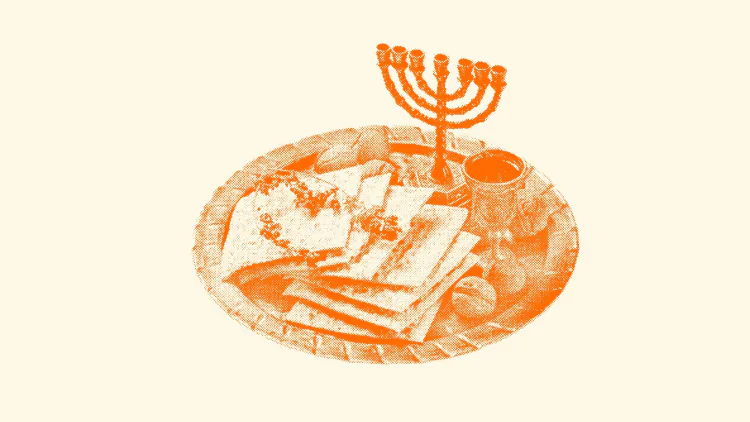The Passover Plot
The dark legacy and ongoing body count of an ancient anti-Semitic myth

This is an edition of Time-Travel Thursdays, a journey through The Atlantic’s archives to contextualize the present and surface delightful treasures. Sign up here.
“Another thing the Gentiles said about us was that we used the blood of murdered Christian children at the Passover festival,” the Russian Jewish immigrant Mary Antin wrote in The Atlantic in 1911. “Of course that was a wicked lie. It made me sick to think of such a thing.” Antin grew up in the Pale of Settlement, an area spanning from modern-day Russia through Ukraine and Poland where Jews were permitted to reside from 1791 to 1915 but deprived of citizenship. Antin’s vivid essay describes her childhood there before coming to America, including the vibrancy of Jewish life at the time as well as its tribulations under the brutal Russian empire.
According to Jewish tradition, during the evening Passover meal, or seder, children are called upon to ask four ceremonial questions about the holiday, prompting explanations from their elders about the festival’s observance. As Antin noted, this practice meant that as a small child, she knew more about Passover than the adult anti-Semites who assailed her co-religionists in ignorance. “When I asked the Four Questions, about the unleavened bread and the bitter herbs and the other things, and the family, reading from their books, answered me, did I not know all about Passover, and what was on the table, and why?” she observed. “It was wicked of the Gentiles to tell lies about us. The youngest child in the house knew how Passover was kept.”
A Jewish youth might have known in the early 1900s that Jews did not prepare their Passover food with Christian blood, but for centuries, this point has been far from obvious to others. The allegation of Jewish ritual murder of non-Jewish children, often linked to Passover, is known as the “blood libel,” and it originated in medieval Europe in the 12th century. Initially condemned by church authorities, the charge gained legitimacy in 1475, after the murder of a toddler named Simon of Trent led to the torture and conviction of the city’s Jewish residents—some of whom were burnt at the stake—and the establishment of a Christian cult to venerate their alleged victim.
The Fordham University historian Magda Teter follows the spread of these deadly allegations, which exploded after the successful Trent prosecution, in her 2020 book, Blood Libel: On the Trail of an Antisemitic Myth. The work’s accompanying maps trace more than 100 such accusations, delineating them by criteria such as whether there were “legal proceedings” (73 yes, 30 no) or “Jews killed” (31 yes, 55 no, 13 unknown). In 1911, the same year that Antin was published in The Atlantic, a Jewish man named Menachem Mendel Beilis was accused of the murder and mutilation of a 13-year-old boy in Kyiv. Over more than two years, he was imprisoned and tried by the Russian government. Ultimately acquitted, he died in New York in 1934.
Dismissing all of this as ancient history would be comforting. But it’s not. In 2019, a far-right gunman stormed a synagogue in California on the last day of Passover, killing one congregant and injuring several others. The murderer left a manifesto: “You are not forgotten Simon of Trent,” he wrote, “the horror that you and countless children have endured at the hands of the Jews will never be forgiven.” In 2014, CNN’s Wolf Blitzer confronted the Hamas spokesman Osama Hamdan on air with archival footage of him declaring, “We all remember how the Jews used to slaughter Christians in order to mix their blood with their holy matzos,” the Passover flatbread. “This is not a figment of the imagination or something taken from a film; it is a fact acknowledged by their own books and historical evidence.” Hamdan said that his comments were misconstrued but did not recant them—“Will it hurt peace process?” a CNN show subsequently asked on Twitter—and 10 years later, he still holds his official role in Hamas. (That’s job security for you.) Today, you don’t have to look far to find updated Jewish-ritual-murder accusations on social media.
Actual Passover fare, of course, is far more prosaic. In 2010, The Atlantic published its own Passover menu. Disappointingly, none of the entrees included Christian blood. In 2011, Yoni Appelbaum unpacked the origins of Manischewitz, the sickly sweet wine popular on Passover, dubbing the beverage “the 11th plague.”
So much for the blood libel. But fear not. There’s one Passover conspiracy that might be true: that “Passover” may be a mistranslation, and not the real name of the holiday after all.
What's Your Reaction?




















